I must be missing something about how to use rawcopy properly. Basically, I want to create an image of the contents of a disk -- and by that I mean a single drive letter, not the entire physical disk.
The other day, I created a 185GB image file using rawcopy -- and I can't get it to open in ImDisk properly -- it always mounts it and then Windows thinks it is unformatted. So, I decided to do some tests using various methods with a smaller amount of data -- here's the details and my issues:
For example, let's say I have a 500GB physical disk that is partitioned as two partitions that are both NTFS formatted -- and they currently get mounted in Windows as C: and D:. C: is the ~488GB system drive and D: is ~12GB of data. What I'd like to do is make an image of D:, mount that image with ImDisk, and then I can work with it as I please without fear of screwing up the original.
I've actually done this just fine using Erwan's CloneDisk -- and also using the context-sensitive "save disk contents as image file" option of ImDisk. Both of those created an image file that I can mount just fine using ImDisk's context-sensitive "Mount as ImDisk Virtual Disk."
However, everything I have tried using rawcopy has failed to produce an image file that I can properly mount with ImDisk. All of my tests do exactly the same thing as my original 185GB image: Windows thinks it is unformatted. I assume this is all related to offsets or something? But I would expect ImDisk to auto-detect those offsets properly from rawcopy-created image files.
In my testing, I have tried numerous options with rawcopy (based on reading through the threads here, I tried different things). Here are the file sizes that I am getting using different options:
CloneDisk created image: 13,736,217,088 bytes (and mounts fine with ImDisk)
ImDisk GUI created image: 13,736,217,600 bytes (and mounts fine with ImDisk)
Rawcopy attempts (done using "rawcopy \\.\D: blah.img" plus the following options):
13,736,214,528 bytes (using "-m")
13,735,821,312 bytes (using "-md")
13,736,214,528 bytes (using no switches)
Again, I can't get any of the rawcopy images to mount with ImDisk properly. All of them are smaller than what I get from CloneDisk or the ImDisk GUI.
What am I missing here? How can I use rawcopy to make an image of disk contents and have it work like the images from the ImDisk GUI work?
Thanks!
- John













